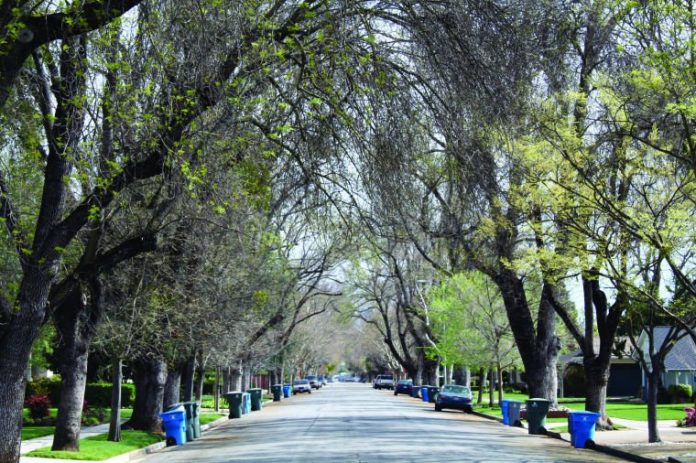Four stately 100-year-old trees lining Fifth Street in Gilroy will soon be absent from the neighborhood skyline, and some aggrieved homeowners are questioning Gilroy’s commitment to live up to its “Tree City USA” moniker.
The designation, first awarded to the city in 1979 and every year since, is given out by the Arbor Day Foundation to communities that implement a viable tree management plan and program.
Long before “Tree City USA” became part of the cultural lexicon, however, the now iconic American elms on Fifth Street were being planted by Gilroy’s famed cattle Baron, Henry Miller, at the turn of the 20th century.
Alas, after avoiding everything that modernity could throw at them, several of the City’s 120 American and English elm trees have been undone by the humble elm leaf beetle – an insect accidentally introduced to the U.S. in the 1830s – and will need to be chopped down, according to an arborist’s report.
Fifth Street’s legendary American elms, some four feet in diameter, reach 50 feet or more above the road, creating a lush canopy as far as the eye can see.
Following a review of Gilroy’s arboreal options during Monday night’s City Council meeting, members decided the American elms on Fifth Street will be replaced with Chinese Pistache trees, which are known for their radiant fall colors. Ten of these were planted on Fifth Street and in other locations around the city about two years ago during the last large scale removal of problem trees.
The four trees slated for removal are located in front of 790 Fifth St.; 820 Fifth St.; 831 Fifth St.; and 7490 Miller Avenue.
As more American and English elms succumb to the beetle and old age, Accolade elms, in addition to the Chinese Pistache trees, will also be used to replace the fallen.
Residents of Fifth Street meet the news with a mix of resignation and anger.
Sergio Arellano, 42, moved to Fifth Street from San Jose two years ago. A major motivating factor in his home purchase, he explained, was the way the trees line the street.
“They add a lot of character,” he said, standing in his driveway and glancing up at the majestic row of trees that have grown so tall and expansive, their branches form a leafy corridor covering Fifth Street for blocks and blocks.
Arellano’s gaze drifted from overhead to across the street, where several Chinese Pistache saplings planted a couple of years ago are dwarfed in the shadows of the 50-foot elms.
“They look nice and colorful in the fall, but they’re not the best tree to have,” he observed.
As news of the City’s plans to remove another four American elms from right outside his house sunk in, Arellano pondered what the future will hold for the abundant foliage that made Fifth Street a major draw for residents and locals who enjoy living, walking, jogging and biking through one of Gilroy’s most lovely neighborhoods.
“I’m sure the people living on the street will work to make the street beautiful again,” he remarked, taking solace in the pride that he and his neighbors share in their small piece of Gilroy.
David Stubchaer, city operations division manager with the Public Works Department, understands the emotional attachment that homeowners on Fifth Street and Miller Avenue have to the trees.
But he’s quick to add: the City’s position on tree removal is not a decision that was hastily arrived at.
“It’s not that we want to take them down, but we have to face reality,” he said.
The notion of replacing the trees with an identical species, Stubchaer explained, was a non-starter because American and English elms are so susceptible to diseases and pests.
A report submitted to the City in 2011 by West Coast Arborists Inc. catalogued the devastation wreaked by the elm leaf beetle and the danger posed to residents by the affected trees. For Stubchaer, the risk of having dead tree limbs falling onto pedestrians is reason enough.
“One guy got his truck smashed twice,” he recalled.
In light of the crushed vehicle and other incidences where tree limbs broke off and fell onto houses, Stubchaer said the City did its due diligence in contacting the homeowners of Fifth Street and Miller Avenue to inform them of plans for a tree cull. For such an emotive subject, Stubchaer was surprised at the lack of interest.
“We got one response,” he stated.
That single response requested that whatever the City decided, “could it at least attempt some kind of uniformity,” said Stubchaer.
It was with that comment in mind that Mayor Pro Tempore Perry Woodward recommended the Fifth Street elms continue to be replaced with Chinese Pistache trees. To do otherwise, reasoned Woodward, would mean a mix of differing tree species on the street or the costly removal of the already-planted Chinese Pistache.
Woodward’s compromise may satisfy the solitary homeowner who responded, but for others who live in the shadows of the giant, elegant trees, the simple fact remains: nothing can bring back what once was.
David Boyer has lived on Fifth Street since 1989 and the loss of the trees is hitting home.
“I hate it now,” said Boyer, 50.
He peered east along Fifth Street, down the line of small Chinese Pistache saplings growing where 100-year-old elms once stood.
“We’ll be dead before the house gets shade again,” he added.
Boyer says more preventative measures should have been taken to safeguard one of Gilroy’s aesthetic landmarks. In the past, he explained, City workers used to trim and top the trees at regular intervals.
“Every five years they’d spray for the beetle,” he noted.
Stubchaer maintains: Everything that could have been done, was. This includes the injection of chemicals into the ground, where it is absorbed by the trees’ roots and ultimately makes the leaves unpalatable to the elm leaf beetle without harming the tree. The City will continue this tactic, along with preventative pruning and additional watering, Stubchaer said.
But it doesn’t make the loss of the dying trees any easier.
“It’s a 1,000 years of trees,” said a visibly moved Boyer, referring to the American elms on Fifth Street that have already been lopped down. Boyer said he misses driving home and turning the corner from Miller Avenue onto Fifth Street.
“It used to be a tree tunnel,” he remarked.
Elva Boyer, 47, stood next to her ex-husband and surveyed the work that had already been done.
“They’re ruining the look of the whole neighborhood,” she assessed, grimly.















